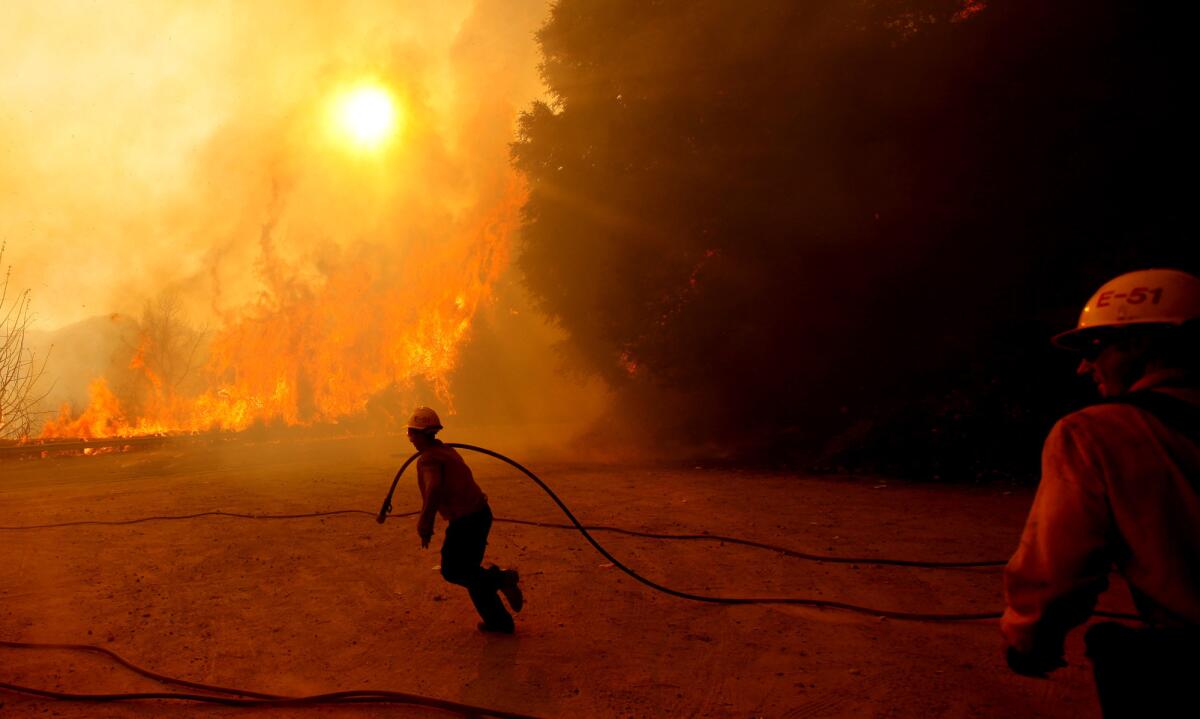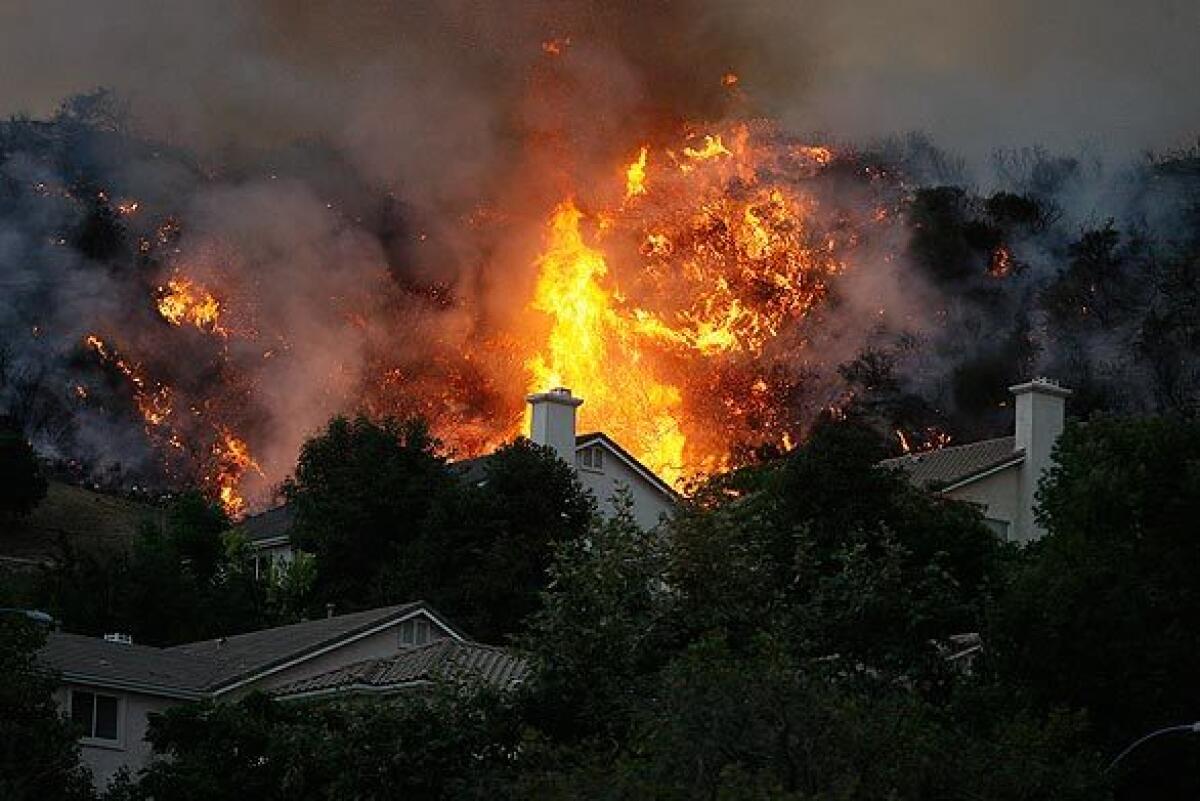10 years on, the Station fire remains burned into the minds of locals and fire officials

At around 3:20 p.m. on Wednesday, Aug. 26, 2009, employees of the U.S. Forest Service’s Angeles Crest Station received a walk-in report of a vegetation fire less than 2 miles north of their tiny outpost in the Angeles National Forest.
By 3:31 p.m. the flare-up was described as “3 acres and running” by forest crews working to douse it. Just five minutes later, however, it found fuel in an area of heavy brush and spread to 10 acres, according Los Angeles County Fire Department reports.
That was the beginning of the Station fire, a conflagration that would go on to consume more than 160,000 acres over a 50-day period, threaten 12,000 homes and structures and cost the lives of Fire Capt. Tedmund “Ted” Hall and Firefighter Specialist Arnaldo “Arnie” Quinones of county Station No. 129, who died in an Aug. 30 vehicle crash while fighting the blaze.
On Wednesday, Hall and Quinones will be honored with the installation of memorial plaques at Acton Park during a service held to recognize the decade that has passed since their sacrifice, according to L.A. County Fire spokesman Capt. Tony Imbrenda.
“For a large number of people whose lives were imperiled that day, the actions of those two guys were pivotal,” he said. “It could have been a much worse tragedy.”
For La Cañadans, the somber anniversary of the Station fire evokes memories of a time when the city was on high alert and brought to full awareness of just how vulnerable residents were living so close to the Angeles National Forest.
“It was like Vesuvius right in your backyard,” said former La Cañada City Councilman Steve Del Guercio, recalling the giant nimbus of smoke that hovered over the city for days. “Ash was pouring everywhere. School was canceled — it was bad.”
Encroachment into La Cañada
In the first days of the Station fire, named for the proximity of its ignition point to the Angeles Crest Station, experts believed it would not cross the ridgeline and move toward La Cañada Flintridge.
But as it devoured dry chaparral-covered hillsides and continued creeping southward, anxious residents on the north end of town gravely weighed whether to flee to safety or stay and defend their homes.
Among them was current Mayor Pro Tem Greg Brown, whose house on Vista Miguel Drive was among those evacuated as fire crews lined residential streets and fought an ever-encroaching fire line from the south.
“I took an SUV, loaded it with all of the stuff that really counted and was irreplaceable, parked it down the street and then got another car,” recalled Brown, who was in his second term on the City Council at the time. “We had to have a council meeting to declare a local emergency — it was unnerving.”
Brown served as part of a small crew of city officials and staff who kept watch as La Cañada City Hall became a 24-hour emergency operations center. Employees and officials fielded calls, posted updates to the city’s website and served as a vital line of communication between citizens and public safety agencies as the Jet Propulsion Laboratory closed its doors and affected residents evacuated to La Cañada High School and boarded their pets through the Pasadena Humane Society.
Working alongside Brown was Del Guercio, who recalls then-Mayor Laura Olhasso sleeping on the floor in between shifts. He said the city’s recently installed “Reverse 911” phone system became a valuable tool for delivering important safety notifications and evacuation orders to residents.
“That was one of the things, looking back, I was most proud of — basically everyone was ready for the emergency and played a helpful role,” he recalled. “We actually became one of the best sources of information for the community.”
By week’s end, the risk to La Cañada Flintridge and its inhabitants had largely passed as the Station fire moved westward — but for La Crescenta and the city of Glendale, the threat loomed.
Deukmejian Park burns
As flames moved across La Crescenta and Glendale, scorching the hills of Deukmejian Wilderness Park, thick, gray smoke blanketed the city. Officials issued evacuation orders for hillside residents, and poor air quality caused Glendale Unified School District to shutter schools for several days.

La Crescenta resident Joanna Linkchorst remembers she was camping in Idyllwild with her family when she first heard the Station fire had hit close to home. They quickly returned and were shocked to see how fire had ravaged the area.
“We saw all these mountainsides burning and the fire coming over toward the mountains behind us,” she recalled.
Rather than evacuate, Linkchorst and her family decided to hunker down at home, figuring they were too far away for the fire to reach them. They blasted the air conditioner as outside temperatures approached triple digits.
Later, in the aftermath of the fire, Linkchorst surveyed the damage at Deukmejian and described it as a profound experience.
“I was amazed at how the rocks broke from the heat, I was amazed at how old the Earth looked … scorched into some moonscape,” she said. “There were actually trees in the middle of all this devastation that survived … it was all so beautiful.”
She said her lasting memory of the Station fire has been watching the regrowth of the area as it rebounds.
“It’s nature doing what it’s supposed to do,” Linkchorst said.
Glendale Fire Chief Silvio Lanzas — who served as a battalion chief in Moreno Valley with the California Department of Forestry and Fire Protection — recalls leading a strike team made up of five engine companies in the first few days of the battle.
For him, memories of the Station fire are almost visceral. Lanzas and his team tackled the blaze from the Acton side before moving on to Soledad Canyon and then Mount Wilson. They were on the hillside the same night Hall and Quinones lost their lives. It was a moment Lanzas said he’ll never forget.
“It definitely gives you a sense of profound realization, as a firefighter and strike team leader, of what you’re doing and what you’re asking your people to do,” he said. “These are people’s husbands, wives, sons, daughters, and you’re the one who’s putting them out there to protect structures and stop this fire.”
Could the threat return?
Within days of its start, investigators announced they believed an arsonist was to blame for the Station fire, but few details were offered. According to a Sept. 4, 2009 Los Angeles Times article, a source close to the investigation said incendiary material had been found near the site.
By late November of that year, investigators said they had not found enough evidence to arrest anyone.
“The conventional wisdom is that the incident was an intentional act,” Imbrenda said this week.
Whether or not an arsonist is lurking, the threat of such a wildfire continues to be real due to the terrain, vegetation and weather conditions in the Angeles National Forest. Once such a blaze gets going, it creates its own weather system.
According to Imbrenda, what made the Station fire so difficult to combat was the unpredictability of its path. Unlike the Woolsey fire, driven by Santa Ana winds, the “plume-dominant” wildland fire remained stationary, sending smoke and combustible material high into the atmosphere.
“When smoke freezes it becomes heavier than the air and collapses back into the plume,” Imbrenda said. “During plume dominance you see erratic winds down in the operational area.”
The key to the size and spread of the Station fire, he added, was the volume of combustible fuel in the Angeles National Forest, which hadn’t seen a significant burn-off in several years before 2009.
While current brush conditions are not quite so dire — given that a wet winter and spring have built a layer of moisture into top layers of soil — Imbrenda said recent periods of dryness and high temperatures are drying out grasses and creating a more threatening fuel load.
“As we move into late August, we’re starting to see higher pressure and heat,” he said. “When that moisture in the soil starts to go away, we start to see the brush dry out and you get a higher probability of ignition — that’s where we’re heading now.”
Brown says he’s glad there’s heightened awareness around the risk of fire throughout California. But, locally, the natural fire break created in the wake of the Station fire is all but gone now, placing La Cañada once again in a precarious situation.
“We’re probably very much back to where we were,” he said. “So we need to pay attention.”
Support our coverage by becoming a digital subscriber.

